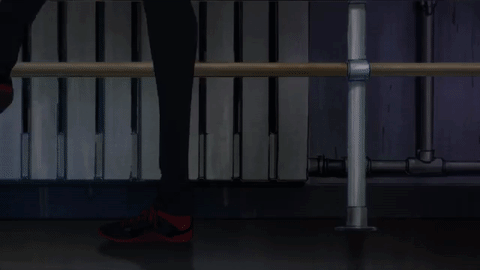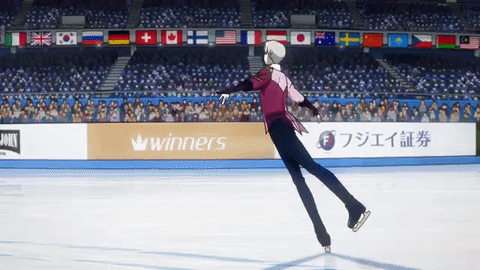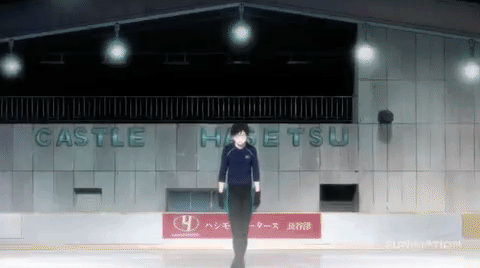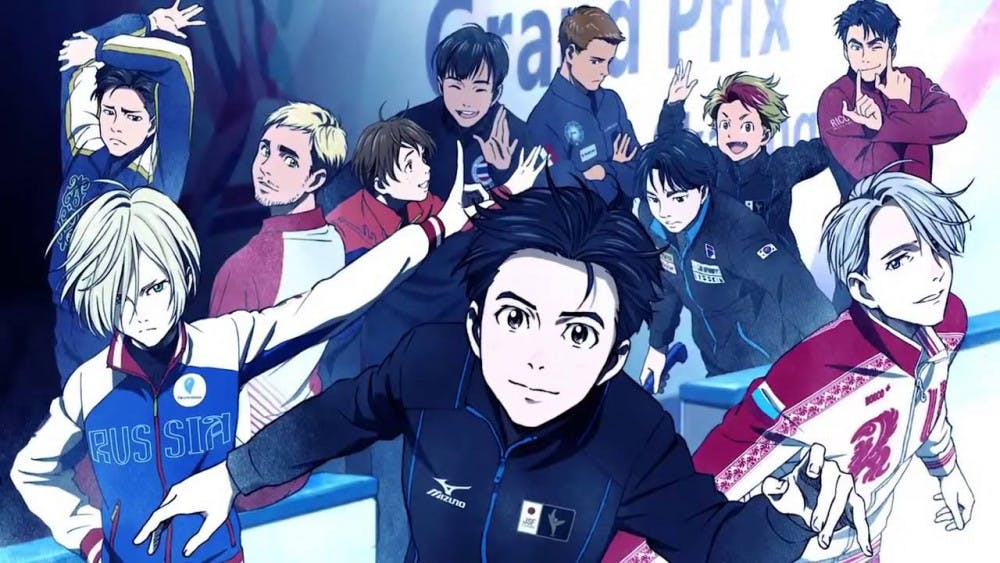by Courtney Tuchman I’ve had a weird desire to see a full-length anime about figure skating ever since the Animator Expo short, Endless Night, premiered. For some strange reason, five minutes of beautifully built men competing in a skating competition wasn’t long enough. I needed more story. Luckily, the man who helped choreograph the skating in Endless Night was promptly assigned to provide the choreography for the ultimate dream come true—a full-length anime about figure skating. Enter Yuri on Ice, possibly one of the biggest titles of the fall 2016 anime season.
The story doesn’t get “cold feet”
The video didn’t just “go viral,” it got retweeted.Yuri on Ice takes the audience on a journey with the titular character, Yuri Katsuki. Yuri has aspired to become a figure skater ever since he observed a performance by his idol, Russian figure skater Victor Nikiforov, as a child. At the start of episode one, Yuri has just suffered a crushing loss at the Grand Prix of Figure Skating Final, which might end up being the nail in the coffin to his career. He takes some time off to recuperate, finishes college and returns to his hometown in Japan. However, one evening while attempting to imitate one of Victor’s winning performances, some local children film the routine. When the video goes viral, Victor takes a flight to Japan, vowing to ensure Yuri’s success in the next national competition by being his coach. From then on, these two strangers embark on global competitions, becoming closer as comrades and possibly even as a romantic pair. One aspect that is so astounding about the story is just how realistic it is. Not only in the figure skating events and their competitive results, but also how this anime isn’t afraid to accept what is up to date and modern. Technology is often a major narrative force. The video didn’t just “go viral,” it got retweeted. Other technologies that have rarely graced anime until now include: hashtags, emojis, FaceTime, Instagram and selfie sticks. While one might argue the inclusion of these current technologies dates the anime (do people even use selfie sticks anymore?), this is more meant to be a product of this time and year. These figure skaters are celebrities. And like any celebrity, they use social media to communicate with their fans about their exploits across each competition. It’s a really welcome addition. While Yuri on Ice falls into the typical anime sports genre, figure skating is, indeed, an art. Each figure skaters’ emotions flourish through their performances and reflect in their training. Don’t be surprised that when you walk away from this show, you might have memorized some of the skating jargon. The insight into the training process is fascinating. This s
 eries isn’t afraid to delve into LGBTQ+ overtones, unapologetically making full use of its flamboyant, and even purposefully effeminate, male characters.
The only drawback of the show’s story is the fan service. One could craft an entire ice-skating rink made out of only screen grabs of fan service scenes. Victor is naked at least once for the first three or four episodes. Sometimes a skater’s choreography is overly sexual, with too many butt close-ups. Therefore, if fan service turns you off, Yuri on Ice isn’t going to ease your concerns.
eries isn’t afraid to delve into LGBTQ+ overtones, unapologetically making full use of its flamboyant, and even purposefully effeminate, male characters.
The only drawback of the show’s story is the fan service. One could craft an entire ice-skating rink made out of only screen grabs of fan service scenes. Victor is naked at least once for the first three or four episodes. Sometimes a skater’s choreography is overly sexual, with too many butt close-ups. Therefore, if fan service turns you off, Yuri on Ice isn’t going to ease your concerns.
Characters are the “icing” on the cake
Yuri is an extremely relatable character. For one, he adores food too much and gains weight easily, which makes it hard for him to maintain a figure skater’s proper weight. When Victor instructs the romantically innocent Yuri to channel sexual love into his routine, Yuri pulls the order off by thinking about pork cutlet bowls, his favorite food—which is hilariously effective. His most standout trait, though, is his anxiety. Yuri’s apprehension is so crippling, he throws competitions because he can’t calm his nerves. Victor ends up becoming the sole person who can relax Yuri, which points to one of the show’s highlights. Yuri is initially so scared of Victor, he can’t even muster up the courage to ask for a photograph of him. But as Yuri becomes more comfortable around his hero, we get to see a delightful, honest-to-God romance blossom between these two. It is so incredibly refreshing to see a modern anime premiere a gay couple that isn’t a stereotype. Intriguingly, these two men hail from two countries that have yet to legalize gay marriage, but their bond is portrayed as entirely acceptable. Their relationship is all too believable, and even groundbreaking at times as far as anime goes. The other figure skaters also receive wonderfully fleshed out backstories and motivations, the standout of the bunch being the Russian Yuri Plisetsky. He’s a teenage brat who initially claims he doesn’t want Japanese Yuri to compete again since he doesn’t want two Yuris in the brackets. But as Russian Yuri works harder toward his goal, he admits he wants to win the Grand Prix because he can already feel his biological clock ticking toward retirement. With Japanese Yuri in the way, he is uncertain if he can become a champion. Too many sports anime have come and gone where other characters are impossible to root for, given that they are never allowed the time to shine in the spotlight. Yuri on Ice successfully makes you feel emotions for each competitor and understand why winning is just as important to them as it is to Yuri. Sometimes the character is likeable (Yuri from Russia) or super uncomfortable (Michele from Italy, who is probably in love with his sister). But nevertheless, we do know them. And that’s awesome.
Speaking of awesome, there is actual diversity in Yuri on Ice, which almost never happens in anime. And again, no one is portrayed as a stereotype, either in personality or looks. For example, the figure skater from the United States is named Leo De La Iglesia. Truly, he is a Mexican-American. We also get characters like Phichit from Thailand, Jean-Jacques from Canada and Otabek from Kazakhstan. Good job, Japan. I applaud you for being so inclusive.
The only characters that could have used some more development are Yuri’s friends and family back in Japan. We never really get to hear or see anything from them again after Yuri leaves to compete, except for a few shots of the group gathered around the TV to watch competitions. We don’t even get to see their reactions after the final episode when the competition is over, which one would think would be important considering how supportive Yuri’s family is. To be honest, I had forgotten he had a sister until I went back and re-watched the first episode.
Too many sports anime have come and gone where other characters are impossible to root for, given that they are never allowed the time to shine in the spotlight. Yuri on Ice successfully makes you feel emotions for each competitor and understand why winning is just as important to them as it is to Yuri. Sometimes the character is likeable (Yuri from Russia) or super uncomfortable (Michele from Italy, who is probably in love with his sister). But nevertheless, we do know them. And that’s awesome.
Speaking of awesome, there is actual diversity in Yuri on Ice, which almost never happens in anime. And again, no one is portrayed as a stereotype, either in personality or looks. For example, the figure skater from the United States is named Leo De La Iglesia. Truly, he is a Mexican-American. We also get characters like Phichit from Thailand, Jean-Jacques from Canada and Otabek from Kazakhstan. Good job, Japan. I applaud you for being so inclusive.
The only characters that could have used some more development are Yuri’s friends and family back in Japan. We never really get to hear or see anything from them again after Yuri leaves to compete, except for a few shots of the group gathered around the TV to watch competitions. We don’t even get to see their reactions after the final episode when the competition is over, which one would think would be important considering how supportive Yuri’s family is. To be honest, I had forgotten he had a sister until I went back and re-watched the first episode.
“Chillingly” good animation, except when it’s not
These techniques cause the skating sequences to feel like these tumbling bodies are animated via motion capture or taken straight from live performances.The animation for Yuri on Ice is varied. The first episode is absolutely stunning. Everything was nearly flawless. The background art. The skating animation. The expressions. But unfortunately, it seems like the animators at studio MAPPA blew their budget too early, because the animation quality dips with each episode. The animation never becomes distractingly bad, but the differences are most noticeable during the skating sequences. Yuri on Ice’s most beautifully animated scenes come from the skating routines, which is to be expected. Clearly, the most important characters get the best skating animation, being the two Yuris and Victor. Everyone else varies from exceptional to “where did all of the key frames go?” Shots of an unmoving or badly animated audience shamefully creep into the show more frequently as it runs its course. It’s obvious these shots were only put in to save money.
 When the animation does work, it works really well. The audience gets to peak into the individual skater’s thoughts during the performance, but I often found myself not wanting to read the subtitles just so I could keep watching the spectacle. Each skater has a different, subtle way of moving too. Russian Yuri, who is 15 and one of the smallest competitors, always looks like he is flying across the ice. Victor, who is 27, and much taller and heavier, feels steadier and more connected to the ground while he skates. His jumps don’t reach as high as the 15-year-old, nor can he skate quite as fast. These techniques cause the skating sequences to feel like these tumbling bodies are animated via motion capture or taken straight from live performances.
When the animation does work, it works really well. The audience gets to peak into the individual skater’s thoughts during the performance, but I often found myself not wanting to read the subtitles just so I could keep watching the spectacle. Each skater has a different, subtle way of moving too. Russian Yuri, who is 15 and one of the smallest competitors, always looks like he is flying across the ice. Victor, who is 27, and much taller and heavier, feels steadier and more connected to the ground while he skates. His jumps don’t reach as high as the 15-year-old, nor can he skate quite as fast. These techniques cause the skating sequences to feel like these tumbling bodies are animated via motion capture or taken straight from live performances.
“Ice” to hear great music and sound design
The music is fitting and uplifting. Every character’s chosen songs for his routines not only fits his personality, but it also fits the country from which he hails. The Russian skaters often contain large, echoing choruses. The skater from the United States uses a hip-hop song for his routine. Despite the fact that many of the songs are replayed over and over, they never get repetitive because the music is just that enjoyable and suitable. are sweet treats and nearly un-skippable. The opening features sketched, yet smooth and stylistic drawings of the two Yuris and Victor, skating against an initially pale-colored background. As the show progresses, deeper and vibrant colors seep their way into the opening, simultaneously reflecting Yuri’s budding relationship with Victor. The ending focuses on the technology aspect, flipping through each skater’s Instagram pictures. Anime productions rarely put enough effort into endings, but the song and imagery are just as good, if not better, than the opening. My only complaint with the voice acting comes from the dub. FUNimation is responsible for the English simuldub, and although it’s fine on the surface, I have a major issue with the accents given to foreign characters. It would be fine if every character had an accent. In fact, giving everyone an accent would make the most sense. But FUNimation only picked a few characters to keep their accents, while the rest are standard American. The Russians, Italians and Swiss have accents, but the Japanese, Korean, Chinese and several other characters don’t. These acting choices come across as a bit distasteful.
My only complaint with the voice acting comes from the dub. FUNimation is responsible for the English simuldub, and although it’s fine on the surface, I have a major issue with the accents given to foreign characters. It would be fine if every character had an accent. In fact, giving everyone an accent would make the most sense. But FUNimation only picked a few characters to keep their accents, while the rest are standard American. The Russians, Italians and Swiss have accents, but the Japanese, Korean, Chinese and several other characters don’t. These acting choices come across as a bit distasteful.




















